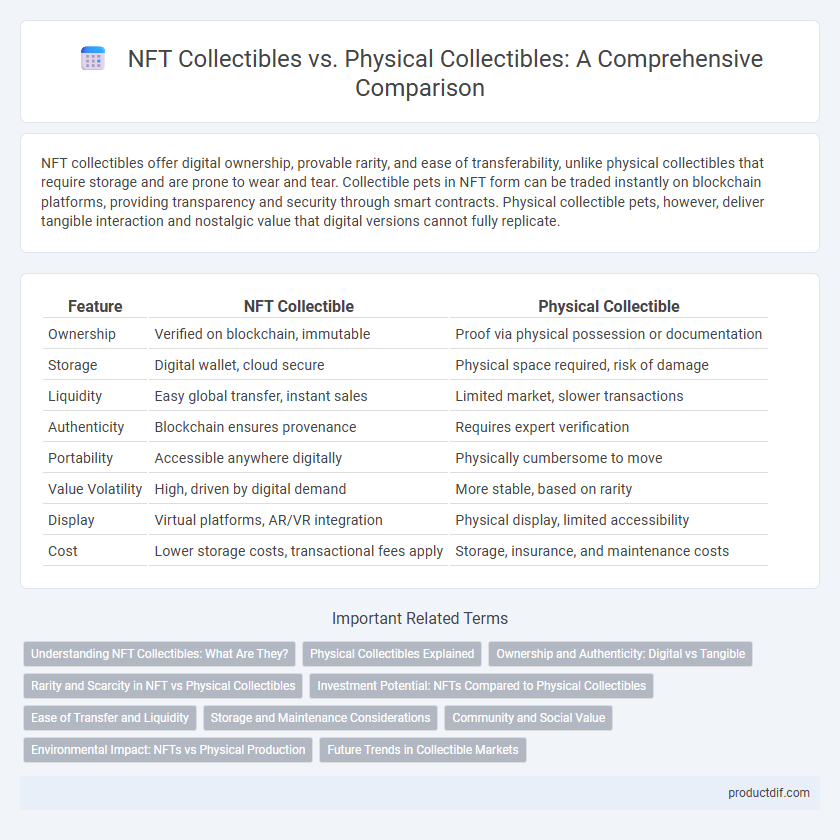NFT collectibles offer digital ownership, provable rarity, and ease of transferability, unlike physical collectibles that require storage and are prone to wear and tear. Collectible pets in NFT form can be traded instantly on blockchain platforms, providing transparency and security through smart contracts. Physical collectible pets, however, deliver tangible interaction and nostalgic value that digital versions cannot fully replicate.
Table of Comparison
| Feature | NFT Collectible | Physical Collectible |
|---|---|---|
| Ownership | Verified on blockchain, immutable | Proof via physical possession or documentation |
| Storage | Digital wallet, cloud secure | Physical space required, risk of damage |
| Liquidity | Easy global transfer, instant sales | Limited market, slower transactions |
| Authenticity | Blockchain ensures provenance | Requires expert verification |
| Portability | Accessible anywhere digitally | Physically cumbersome to move |
| Value Volatility | High, driven by digital demand | More stable, based on rarity |
| Display | Virtual platforms, AR/VR integration | Physical display, limited accessibility |
| Cost | Lower storage costs, transactional fees apply | Storage, insurance, and maintenance costs |
Understanding NFT Collectibles: What Are They?
NFT collectibles are unique digital assets verified using blockchain technology, ensuring authenticity and ownership through smart contracts. Unlike physical collectibles, NFTs can be easily traded globally without the risk of damage or loss, offering verifiable scarcity and provenance. These digital items range from art and music to virtual real estate, providing new opportunities for collectors in the digital economy.
Physical Collectibles Explained
Physical collectibles are tangible items such as rare coins, stamps, action figures, or vintage toys that hold intrinsic value due to their rarity, condition, and historical significance. These collectibles can be displayed, exchanged, or preserved, offering a sensory experience and authenticity that digital assets cannot replicate. Their value often depends on physical preservation, provenance, and market demand within specialized collector communities.
Ownership and Authenticity: Digital vs Tangible
NFT collectibles provide indisputable digital ownership secured by blockchain technology, ensuring transparent provenance and preventing forgery, while physical collectibles rely on certificates of authenticity or expert appraisal to verify ownership and legitimacy. Digital NFTs offer verifiable scarcity and immutable records, eliminating risks of counterfeit or damage associated with tangible items. Physical collectibles, however, carry intrinsic value through tactile experience and historical presence, which digital assets cannot replicate.
Rarity and Scarcity in NFT vs Physical Collectibles
NFT collectibles offer verifiable rarity through blockchain technology, ensuring each token's uniqueness and provenance without risk of duplication. Physical collectibles rely on tangible scarcity, often limited by production or surviving quantity, but face challenges like counterfeiting and wear over time. The digital nature of NFTs enhances scarcity with programmable supply caps, making rarity transparent and immutable compared to traditional collectibles.
Investment Potential: NFTs Compared to Physical Collectibles
NFT collectibles offer enhanced liquidity and global market access, making them attractive for rapid investment and trading compared to traditional physical collectibles, which often require extensive authentication and storage. The transparent blockchain technology underpinning NFTs provides verifiable ownership and provenance, reducing risks of fraud that can diminish physical collectible value. While physical collectibles may appreciate due to rarity and historical significance, NFTs' programmable nature and potential for royalties create novel revenue streams, diversifying investment potential beyond conventional asset classes.
Ease of Transfer and Liquidity
NFT collectibles offer superior ease of transfer and liquidity compared to physical collectibles due to their digital nature and blockchain-based ownership verification. Digital marketplaces enable instant transactions and global access without the need for shipping or physical exchange, enhancing liquidity. Physical collectibles often require in-person transactions or shipping logistics, which can delay transfer and reduce overall market fluidity.
Storage and Maintenance Considerations
NFT collectibles require minimal physical storage space and involve no risk of damage from environmental factors, as they exist entirely in digital form on blockchain platforms. Physical collectibles demand careful storage conditions, such as controlled temperature and humidity, to prevent deterioration, along with regular maintenance to preserve their value and appearance. Choosing between NFT and physical collectibles depends on preferences for tangibility versus convenience, with digital assets offering easier management but lacking physical presence.
Community and Social Value
NFT collectibles foster vibrant online communities where ownership, trading, and collaboration create dynamic social value through digital interaction and shared experiences. Physical collectibles build face-to-face connections and tangible group identities, often rooted in nostalgia and communal events that enhance social bonding. Both forms leverage exclusivity and scarcity to cultivate passionate communities, driving engagement and collective enthusiasm.
Environmental Impact: NFTs vs Physical Production
NFT collectibles significantly reduce environmental impact by eliminating the need for physical materials, transportation, and manufacturing processes associated with traditional collectibles. However, the blockchain technology powering NFTs, particularly proof-of-work systems, can consume substantial energy, raising concerns about carbon footprints. Transitioning to energy-efficient blockchains like proof-of-stake can mitigate these issues, positioning NFTs as a more sustainable alternative to physical collectibles.
Future Trends in Collectible Markets
NFT collectibles are revolutionizing the market by enabling verifiable ownership, instant global transfer, and programmable rarity through blockchain technology. Physical collectibles, while timeless in value, face challenges in liquidity and authenticity verification compared to their digital counterparts. Future trends indicate a hybrid market where augmented reality and metaverse platforms merge digital NFTs with physical collectibles, enhancing provenance and user engagement.
NFT Collectible vs Physical Collectible Infographic

 productdif.com
productdif.com